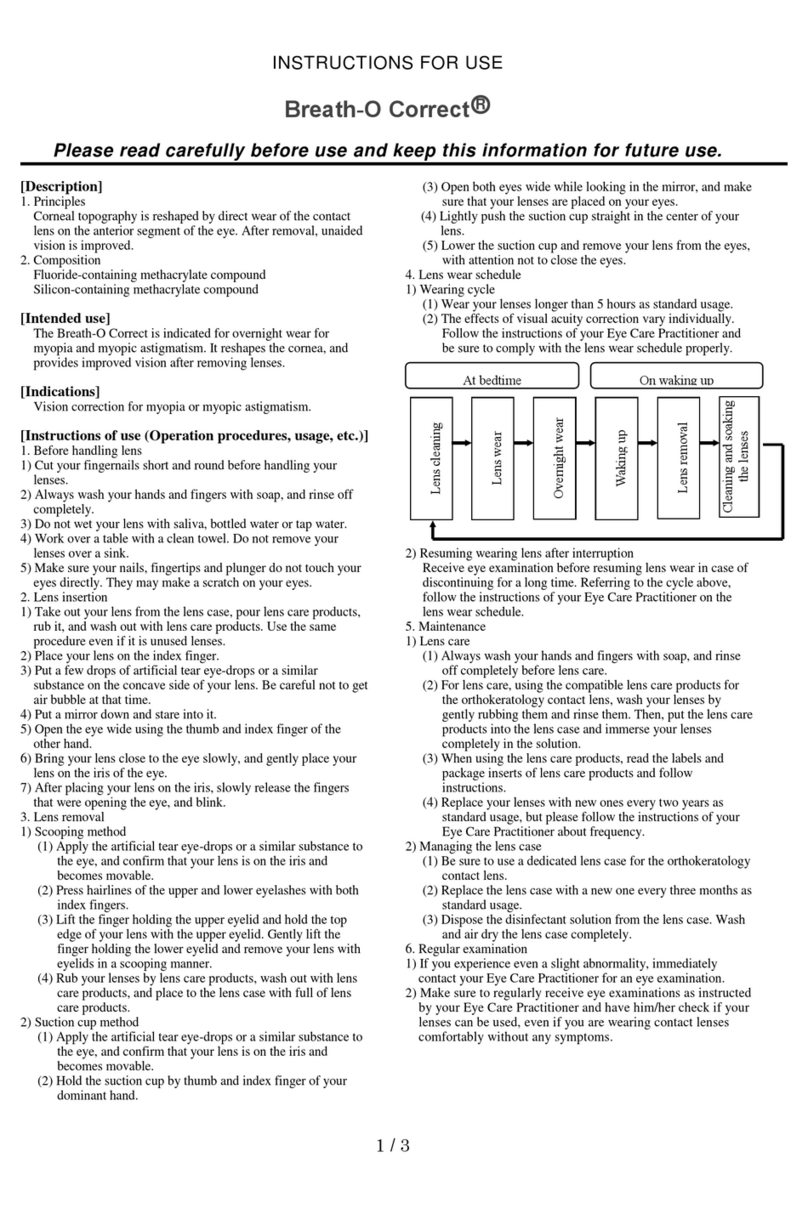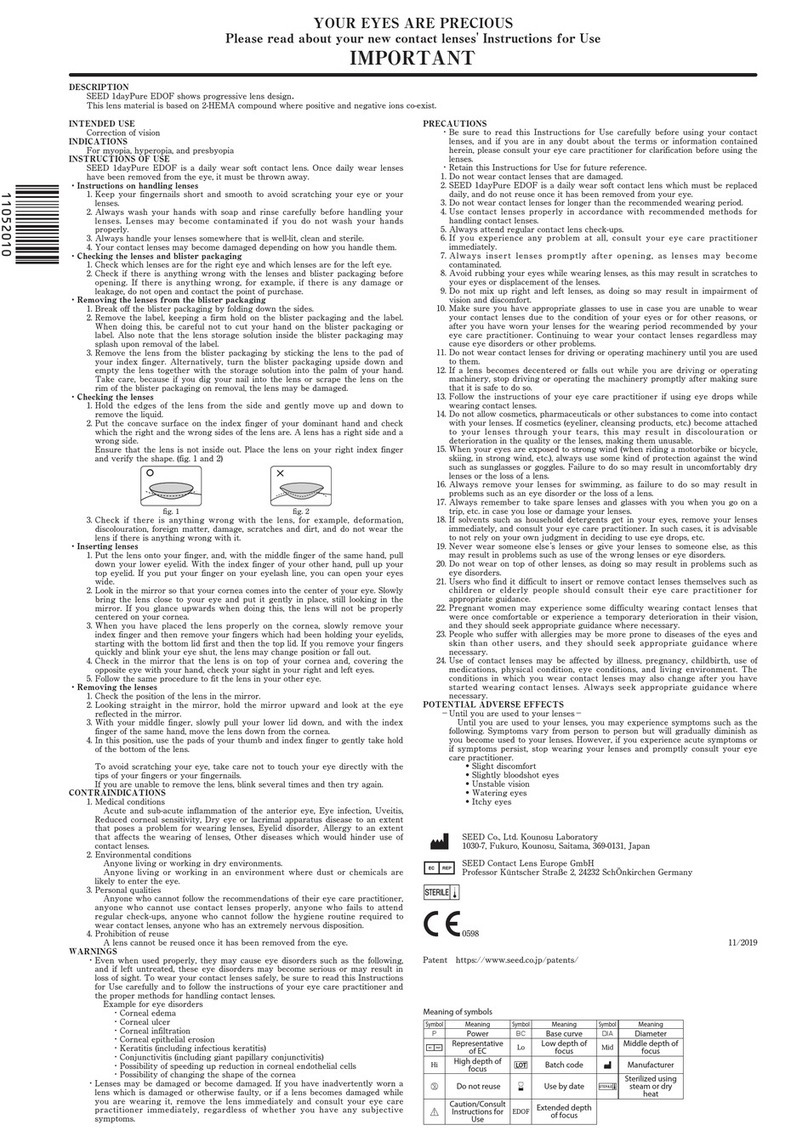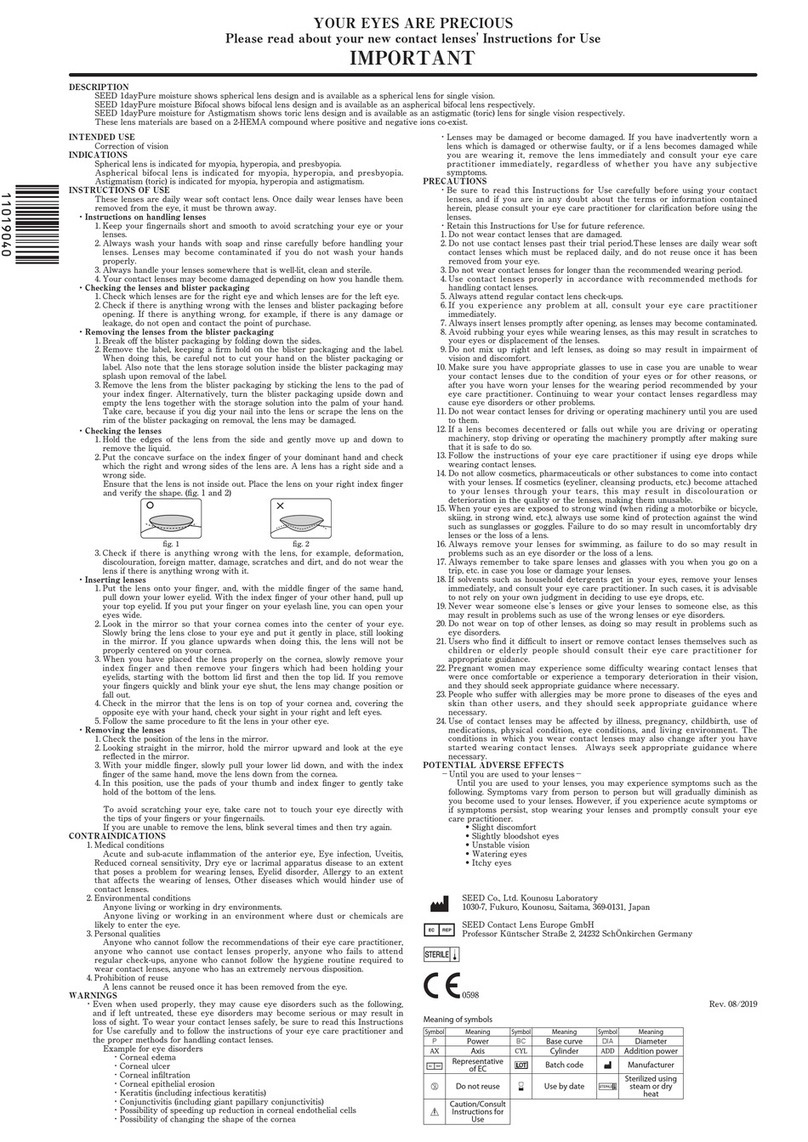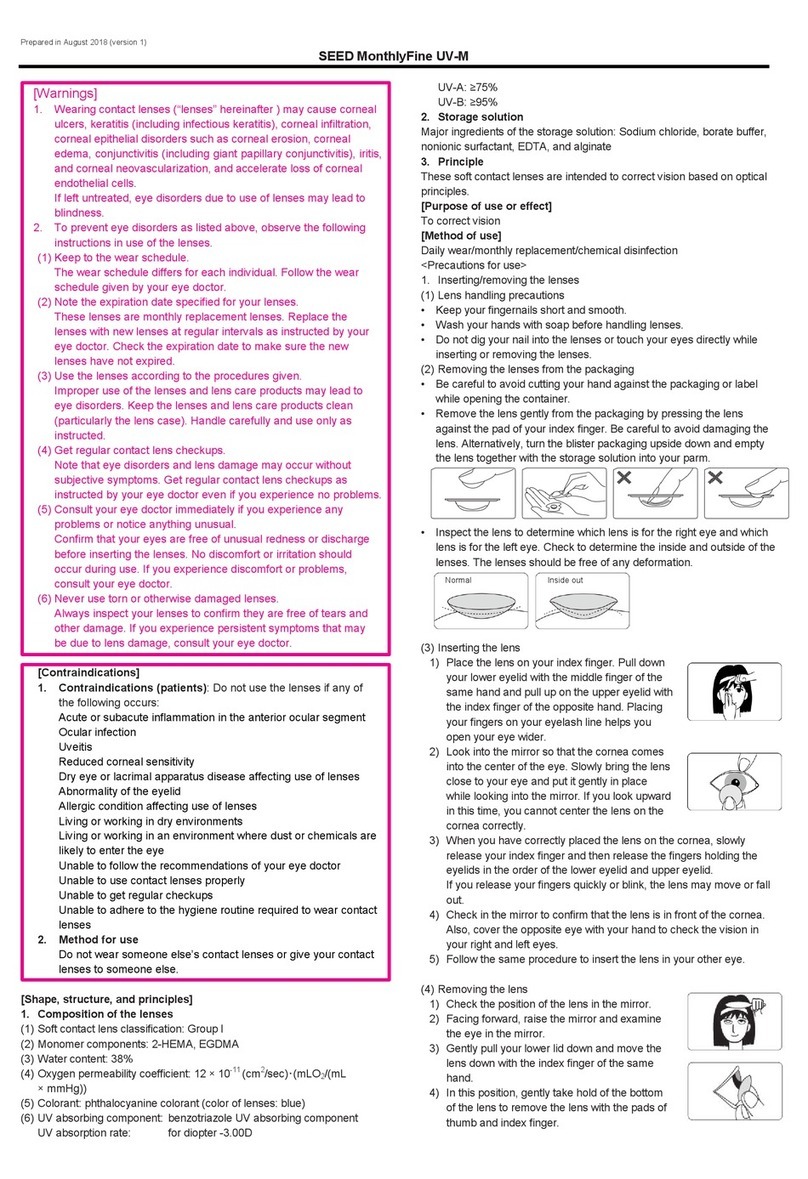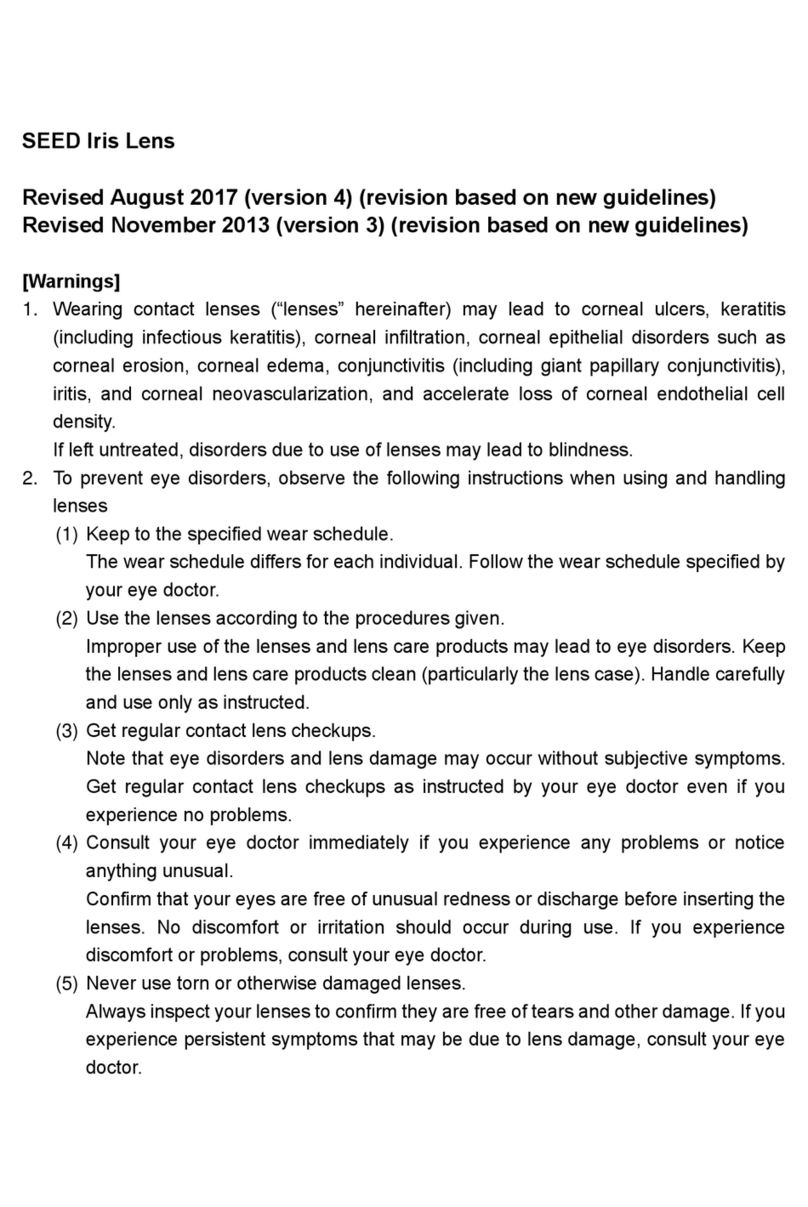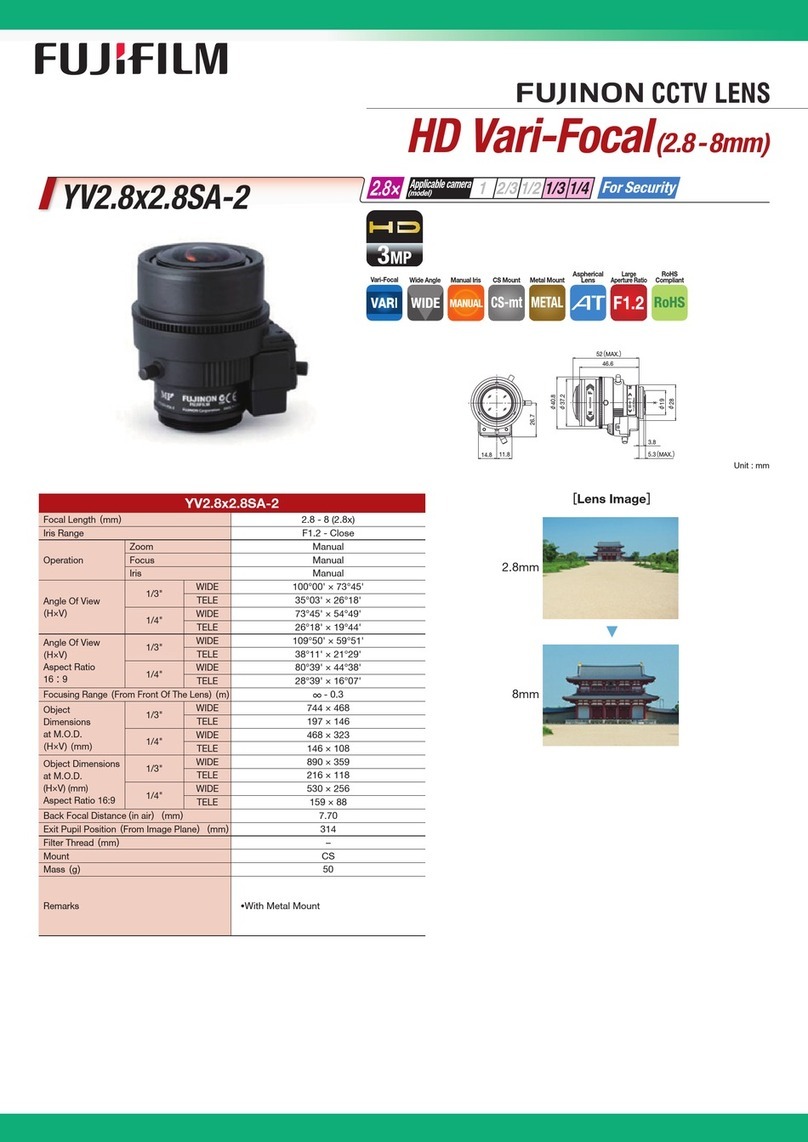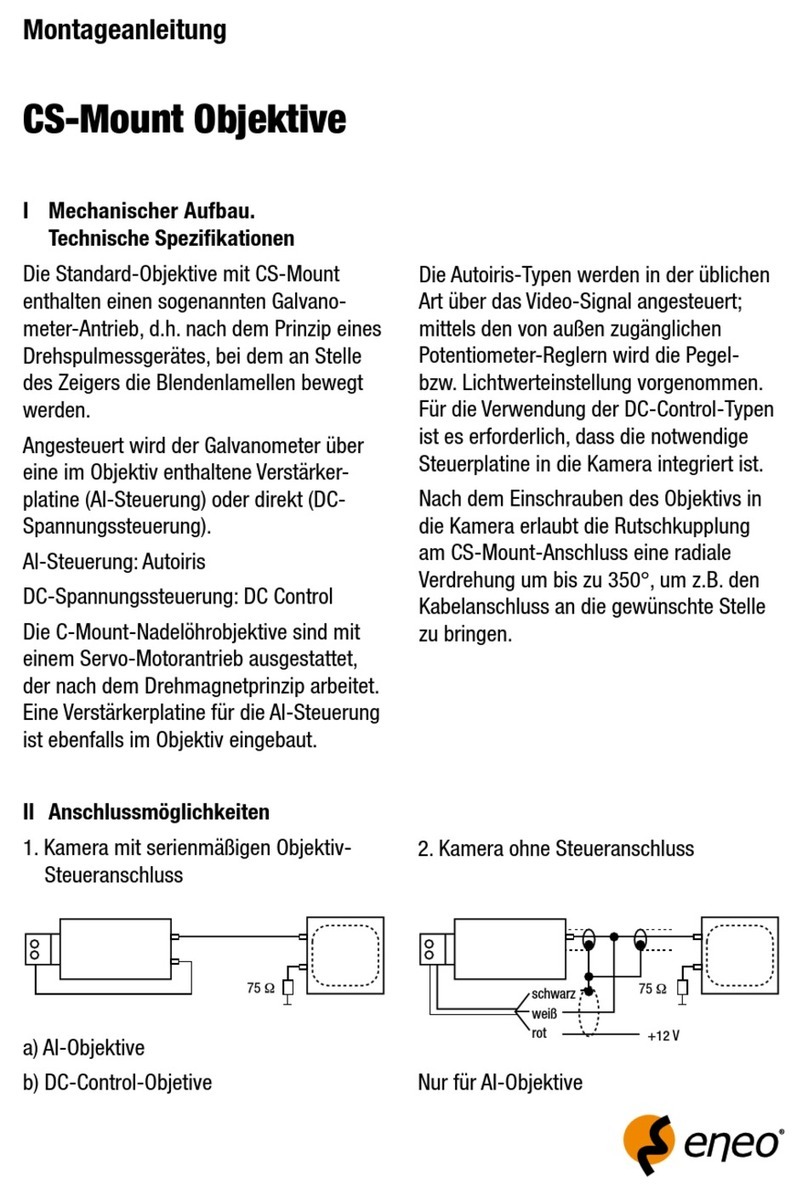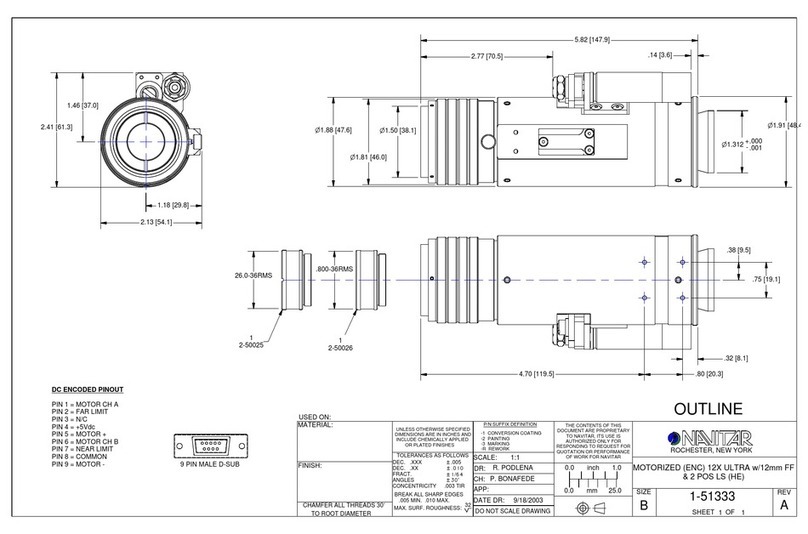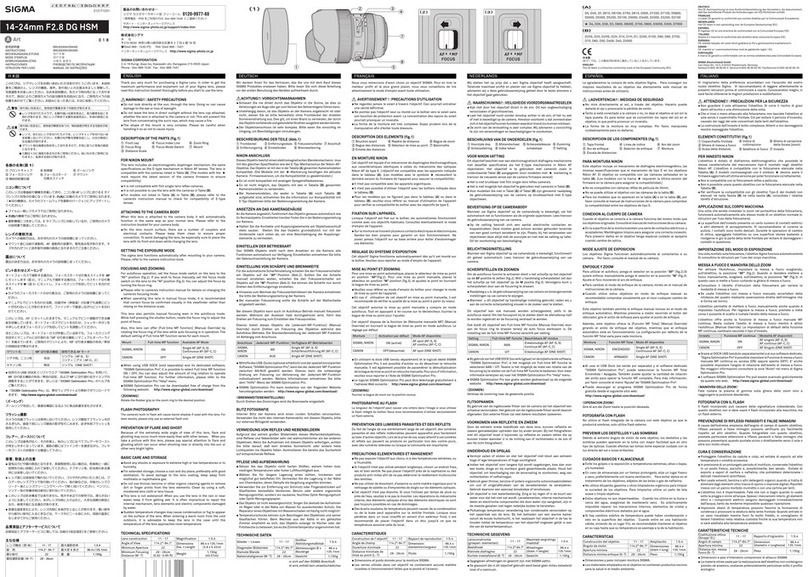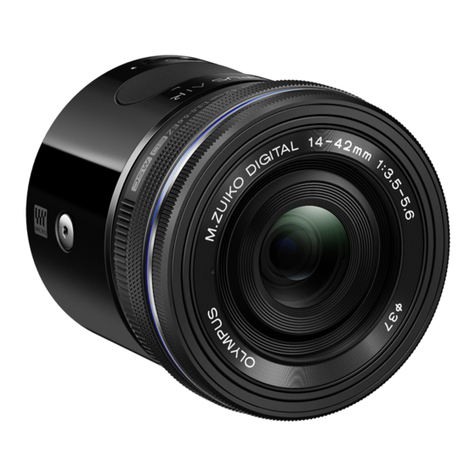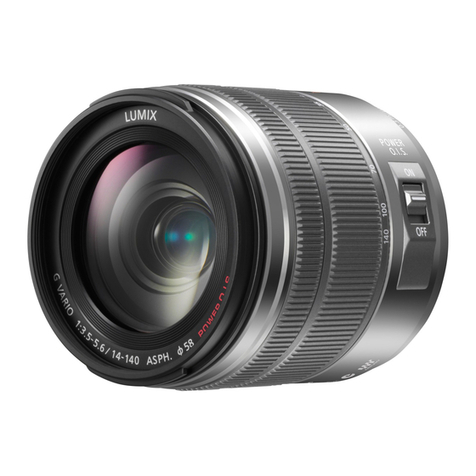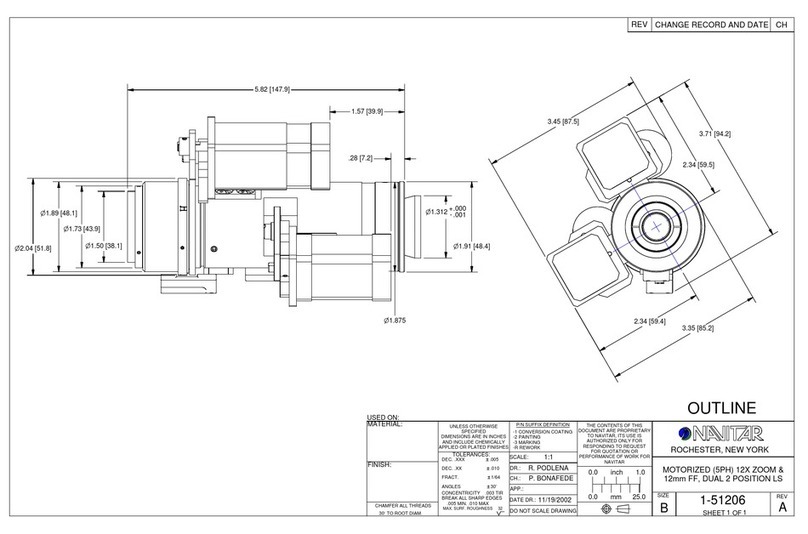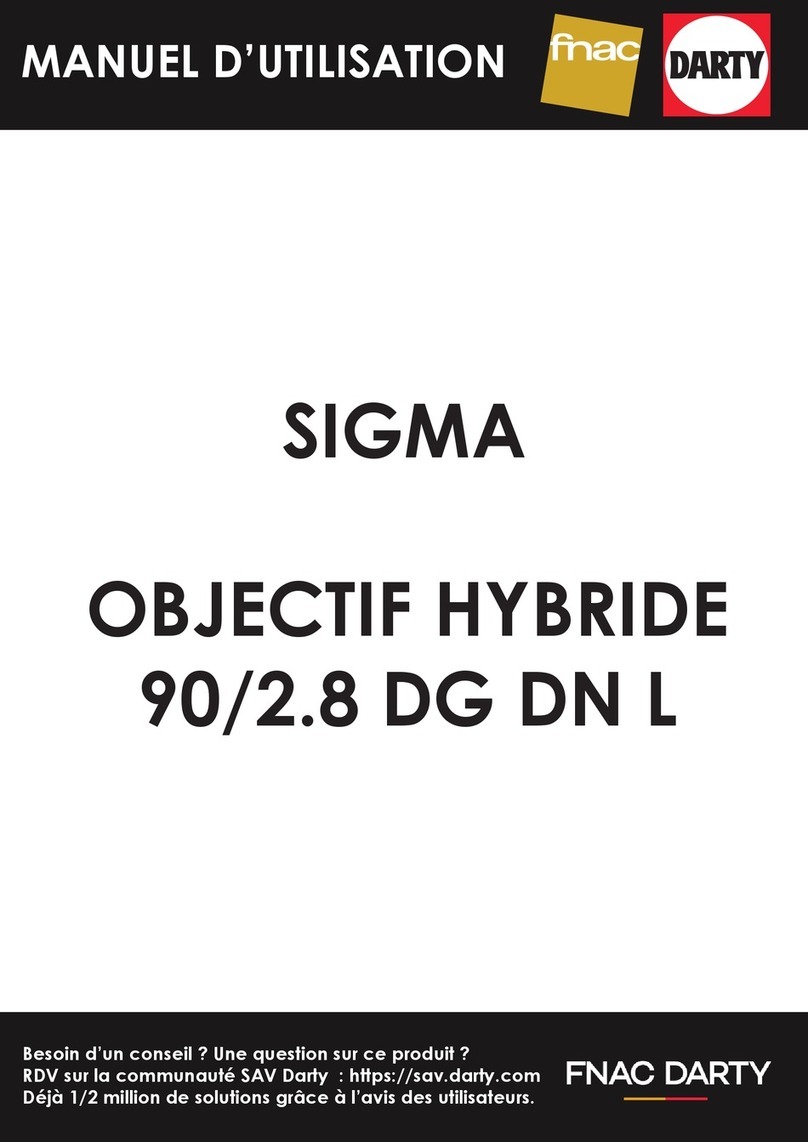Seed 2weekPure moisture User manual

SEED Co., Ltd.
YOUR EYES ARE PRECIOUS
Please read about your new contact lenses' Instructions for Use
IMPORTANT
DESCRIPTION
SEED 2weekPure moisture shows spherical lens design and is available as a spherical lens for single vision.
SEED 2weekPure moisture Bifocal shows bifocal lens design and is available as an aspherical bifocal lens.
SEED 2weekPure moisture for Astigmatism shows toric lens design and is available as an astigmatic (toric) lens for
single vision.
These lens materials are based on a 2-HEMA compound where positive and negative ions co-exist. The lens is
immersed in isotonic buffered saline with Polaxamer 407 and alginic acid.
INTENDED USE
Correction of vision
INDICATIONS
Spherical lens is indicated for myopia, hyperopia.
Aspherical bifocal lens is indicated for myopia, hyperopia, and presbyopia. Astigmatism (toric) is indicated for
myopia, hyperopia and astigmatism.
INSTRUCTIONS OF USE
These lenses are daily wear, 2-week-disposable soft contact lens. Please wear lenses only while awake and
remove them before sleeping. After removing your lenses from your eyes, please follow the proper lens care regimen
by using chemical disinfection system.
・Instructions on handling lenses
1. Keep your fingernails short and smooth to avoid scratching your eye or your lenses.
2. Always wash your hands with soap and rinse carefully before handling your lenses. Lenses may become
contaminated if you do not wash your hands properly.
3. Always handle your lenses somewhere that is well-lit, clean and sterile.
4. Your contact lenses may become damaged depending on how you handle them.
・Checking the lenses and blister packaging
1. Check which lenses are for the right eye and which lenses are for the left eye.
2. Check if there is anything wrong with the lenses and blister packaging before opening. If there is anything
wrong, for example, if there is any damage or leakage, do not open and contact the point of purchase.
・Removing the lenses from the blister packaging
1. Break off the blister packaging by folding down the sides.
2. Remove the label, keeping a firm hold on the blister packaging and the label. When doing this, be careful not
to cut your hand on the blister packaging or label. Also note that the lens storage solution inside the blister
packaging may splash upon removal of the label.
3. Remove the lens from the blister packaging by sticking the lens to the pad of your index finger. Alternatively,
turn the blister packaging upside down and empty the lens together with the storage solution into the palm
of your hand. Take care, because if you dig your nail into the lens or scrape the lens on the rim of the blister
packaging on removal, the lens may be damaged.
・Checking the lenses
1. Hold the edges of the lens from the side and gently move up and down to remove the liquid.
2. Put the concave surface on the index finger of your dominant hand and check which the right and wrong sides
of the lens are. A lens has a right side and a wrong side.
Ensure that the lens is not inside out. Place the lens on your right index finger and verify the shape. (fig. 1
and 2)
fig. 1 fig. 2

SEED Co., Ltd.
3. Check if there is anything wrong with the lens, for example, deformation, discolouration, foreign matter,
damage, scratches and dirt, and do not wear the lens if there is anything wrong with it.
・Inserting lenses
1. Put the lens onto your finger, and, with the middle finger of the same hand, pull down your lower eyelid. With
the index finger of your other hand, pull up your top eyelid. If you put your finger on your eyelash line, you
can open your eyes wide.
2. Look in the mirror so that your cornea comes into the center of your eye. Slowly bring the lens close to your
eye and put it gently in place, still looking in the mirror. If you glance upwards when doing this, the lens will
not be properly centered on your cornea.
3. When you have placed the lens properly on the cornea, slowly remove your index finger and then remove your
fingers which had been holding your eyelids, starting with the bottom lid first and then the top lid. If you
remove your fingers quickly and blink your eye shut, the lens may change position or fall out.
4. Check in the mirror that the lens is on top of your cornea and, covering the opposite eye with your hand, check
your sight in your right and left eyes.
5. Follow the same procedure to fit the lens in your other eye.
・Removing the lenses
1. Check the position of the lens in the mirror.
2. Looking straight in the mirror, hold the mirror upward and look at the eye reflected in the mirror.
3. With your middle finger, slowly pull your lower lid down, and with the index finger of the same hand, move
the lens down from the cornea.
4. In this position, use the pads of your thumb and index finger to gently take hold of the bottom of the lens.
To avoid scratching your eye, take care not to touch your eye directly with the tips of your fingers or your
fingernails.
If you are unable to remove the lens, blink several times and then try again.
・Lens care
1. Since protein and lipids present in your tears will become attached to the surface of your contact lenses as
you wear them, it is important to follow the lens care regimen for washing, rinsing, disinfecting and storing
your lenses. Failure to follow the lens care regimen will result in lenses becoming dirty and may result in
serious eye disorders or eye infections.
2. Use lens care products suitable for soft contact lenses. You can use a chemical disinfection system.
3. Use lens care products according to their Instructions for Use.
4. The extent to which lenses become dirty varies from person to person. If your lenses tend to become dirty,
try rubbing your lenses with a cleaning solution or using a protein removal liquid. If the dirt will not come
off, even if you have not worn the lens for a full two weeks, replace it with a new one.
5. When following the lens care regimen, use a plug or contact lens sink mat to prevent the lenses from being
washed away.
6. Empty and clean contact lens cases with digital rubbing using fresh, sterile disinfecting solutions/contact
lens cleaner (never use water), followed by rinsing with fresh, sterile disinfecting solutions (never use water)
and wiping the lens cases with fresh, clean tissue is recommended.
7. Replace your lens case roughly every one or two months. Prolonged use will result in a proliferation of
bacteria due to the build-up of dirt, rendering disinfection inadequate and leading to eye disorders or
infections.
8. Do not change the contact lens care system without consulting an eye care professional.
CONTRAINDICATIONS
1. Medical conditions
Acute and sub-acute inflammation of the anterior eye, Eye infection, Uveitis, Reduced corneal sensitivity,
Dry eye or lacrimal apparatus disease to an extent that poses a problem for wearing lenses, Eyelid disorder,
Allergy to an extent that affects the wearing of lenses, Other diseases which would hinder use of contact
lenses.
2. Environmental conditions.
Anyone living or working in dry environments.
Anyone living or working in an environment where dust or chemicals are likely to enter the eye.

SEED Co., Ltd.
3. Personal qualities
Anyone who cannot follow the recommendations of their eye care practitioner, anyone who cannot use
contact lenses properly, anyone who fails to attend regular check-ups, anyone who cannot follow the hygiene
routine required to wear contact lenses, anyone who has an extremely nervous disposition.
WARNINGS
・Even when used properly, wearing contact lenses may cause eye disorders such as the following, and if left
untreated, these eye disorders may become serious or may result in loss of sight. To wear your contact lenses
safely, be sure to read this Instructions for Use carefully and to follow the instructions of your eye care
practitioner and the proper methods for handling contact lenses.
Example for eye disorders
・Corneal edema ・Corneal ulcer ・Corneal infiltration ・Corneal epithelial erosion
・Keratitis (including infectious keratitis) ・Conjunctivitis (including giant papillary conjunctivitis)
・Possibility of speeding up reduction in corneal endothelial cells
・Possibility of changing the shape of the cornea
・Lenses may be damaged or become damaged. If you have inadvertently worn a lens which is damaged or
otherwise faulty, or if a lens becomes damaged while you are wearing it, remove the lens immediately and
consult your eye care practitioner immediately, regardless of whether you have any subjective symptoms.
PRECAUTIONS
・Be sure to read this Instructions for Use carefully before using your contact lenses, and if you are in any doubt
about the terms or information contained herein, please consult your eye care practitioner for clarification
before using the lenses.
・Retain this Instructions for Use for future reference.
1. Avoid direct sunlight and avoid freezing, store at room temperature.
2. Do not wear contact lenses that are damaged.
3. Do not use contact lenses past their expiration date.
4. Do not wear contact lenses for longer than the recommended wearing period.
5. Use contact lenses properly in accordance with recommended methods for handling contact lenses.
6. Always attend regular contact lens check-ups.
7. If you experience any problem at all, consult your eye care practitioner immediately.
8. Always insert lenses promptly after opening, as lenses may become contaminated. If you do not use the lenses
straight away, store them according to the instructions of the lens care products.
9. Avoid rubbing your eyes while wearing lenses, as this may result in scratches to your eyes or displacement of
the lenses.
10. Do not mix up right and left lenses, as doing so may result in impairment of vision and discomfort.
11. Make sure you have appropriate glasses to use in case you are unable to wear your contact lenses due to the
condition of your eyes or for other reasons, or after you have worn your lenses for the wearing period
recommended by your eye care practitioner. Continuing to wear your contact lenses regardless may cause eye
disorders or other problems.
12. Do not wear contact lenses for driving or operating machinery until you are used to them.
13. If a lens becomes decentered or falls out while you are driving or operating machinery, stop driving or operating
the machinery promptly after making sure that it is safe to do so.
14. Follow the instructions of your eye care practitioner if using eye drops while wearing contact lenses.
15. Do not allow cosmetics, pharmaceuticals or other substances to come into contact with your lenses. If cosmetics
(eyeliner, cleansing products, etc.) become attached to your lenses through your tears, this may result in
discolouration or deterioration in the quality or the lenses, making them unusable.
16. When your eyes are exposed to strong wind (when riding a motorbike or bicycle, skiing, in strong wind, etc.),
always use some kind of protection against the wind such as sunglasses or goggles. Failure to do so may result
in uncomfortably dry lenses or the loss of a lens.
17. Consult the eye care professional about wearing lenses during sporting and water related activities. Exposure
to water while wearing contact lenses in activities such as swimming, water skiing, and hot tubs may increase
the risk of ocular infection, including but not limited to Acanthamoeba keratitis.
18. Never allow contact lenses to come into contact with non-sterile liquids (including tap water and saliva) as

SEED Co., Ltd.
microbial contamination can occur, which may lead to permanent eye damage.
19. Always remember to take spare lenses and glasses with you when you go on a trip, etc. in case you lose or
damage your lenses.
20. Never wear someone else’s lenses or give your lenses to someone else, as this may result in problems such as
use of the wrong lenses or eye disorders.
21. Do not wear on top of other lenses, as doing so may result in problems such as eye disorders.
22. Do not use anything other than lens care products (for example, tap water) to care for your lenses. Also do not
use a mixture of different types of lens care products, as this may result in eye disorders or cause deformation
of the lenses, making them unusable.
23. Users who find it difficult to insert or remove contact lenses themselves such as children or elderly people
should consult their eye care practitioner for appropriate guidance.
24. Pregnant women may experience some difficulty wearing contact lenses that were once comfortable or
experience a temporary deterioration in their vision, and they should seek appropriate guidance where
necessary.
25. People who suffer with allergies may be more prone to diseases of the eyes and skin than other users, and they
should seek appropriate guidance where necessary.
26. Use of contact lenses may be affected by illness, pregnancy, childbirth, use of medications, physical condition,
eye conditions, and living environment. The conditions in which you wear contact lenses may also change after
you have started wearing contact lenses. Always seek appropriate guidance where necessary.
27. Always check the expiry and disinfect the contact lenses before wearing if they have not been worn for a length
of time.
28. Consult your eye care professional if you wish to change the lens type or parameters.
POTENTIAL ADVERSE EFFECTS
―Until you are used to your lenses―
Until you are used to your lenses, you may experience symptoms such as the following. Symptoms vary from
person to person but will gradually diminish as you become used to your lenses. However, if you experience
acute symptoms or if symptoms persist, stop wearing your lenses and promptly consult your eye care
practitioner.
• Slight discomfort • Slightly bloodshot eyes • Unstable vision • Watering eyes • Itchy eyes
WEARING SCHEDULE
1. This is a daily wear, 2-week-disposable contact lens. Please wear the lenses only while awake and remove them
before sleeping.
2. The wearing and replacement schedules should be determined by the eye care professional as individual
response to contact lenses varies. Regular checkups or follow ups, as determined by the eye care professional,
are also very important.
(Suggested Schedule)
Day
1
2
3
4-6
7 and after
Hours
6
8
10
12
All waking hours
(12~14)
3. In cases where contact lens wear is stopped for:
Less than a week - please start by shortening the wearing schedule by 2 to 4 hours.
More than a week - please start by referring to the table above.
More than 1 month - please consult your eye care professional before starting the contact lens wear.
EMERGENCIES
Patient should be informed that if chemicals of any kind (household products, gardening solutions, laboratory
chemicals, etc.) are splashed into the eyes, the patient should: Flush eyes immediately with tap water or fresh
saline solution, remove and discard the lens, and immediately contact the eye care professional or visit a hospital
emergency room without delay.

SEED Co., Ltd.
SEED Co., Ltd. Kounosu Laboratory
1030-7, Fukuro, Kounosu, Saitama, 369-0131, Japan
SEED Contact Lens Europe GmbH
Professor-Küntscher-Straße 2, 24232 Schönkirchen, Germany 1639
Rev. 08/2020
Meaning of symbols
Symbol
Meaning
Symbol
Meaning
Symbol
Meaning
Power
Base curve
Diameter
AX
Axis
CYL
Cylinder
ADD
Addition power
Representative
of EC
Batch code
Manufacturer
Caution/Consult
Instructions for
Use
Use by date
Sterilized using
steam or dry
heat
Follow
instructions
for use
SPH
2week
replacement
spherical
contact lens
TC
2week
replacement
astigmatic
contact lens
MS
2week
replacement
bifocal
contact lens
Other Seed Lens manuals
Popular Lens manuals by other brands

Canon
Canon EF-S18-135mm f/3.5-5.6 IS STM manual

Nikon
Nikon AF-S Zoom-Nikkor ED 14-24mm/F2.8G (IF) Repair manual
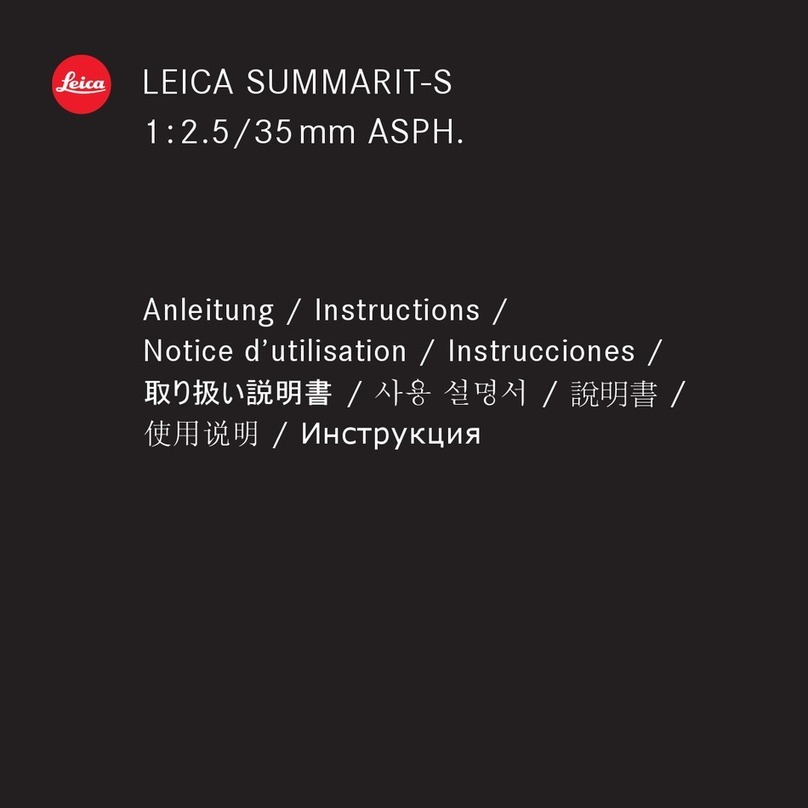
Leica
Leica SUMMARIT-S 1:2.5/35mm ASPH instructions

Mitsubishi Electric
Mitsubishi Electric OL-XL2550MZ Replacement manual

Vivitar
Vivitar 500MR F/6.3 instruction manual

Canon
Canon KJ10EX4.5B IRSE Operation manual
